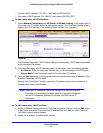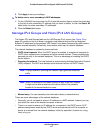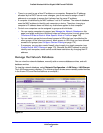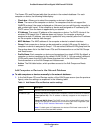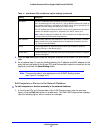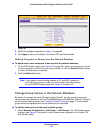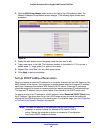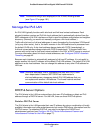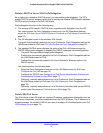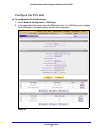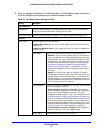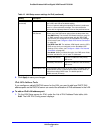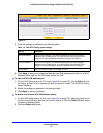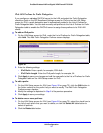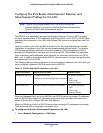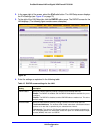
LAN Configuration
71
ProSafe Wireless-N 8-Port Gigabit VPN Firewall FVS318N
Stateless DHCPv6 Server With Prefix Delegation
As an option for a stateless DHCPv6 server, you can enable prefix delegation. The ISP’s
stateful DHCPv6 server assigns a prefix that is used by the wireless VPN firewall’s stateless
DHCPv6 server to assign to its IPv6 LAN clients.
Prefix delegation functions in the following way:
1. The wireless VPN firewall’
s DHCPv6 client requests prefix delegation from the ISP.
You need to select the Prefix Delegation check box on the ISP Broadband Settings
screen for IPv6 (see Use a DHCPv6 Server to Configure an IPv6 Internet Connection on
page 37).
2. The ISP allocates a pref
ix to the wireless VPN firewall.
This prefix is automatically added to the List of Prefixes for Prefix Delegation table on the
L
AN Setup screen for IPv6 (see IPv6 LAN Prefixes for Prefix Delegation on
page 76).
3. The st
ateless DHCPv6 server allocates the prefix to the IPv6 LAN clients through the
RADVD. When prefix delegation is enabled, the RADVD advertises the following prefixes:
• T
he prefix that was added through prefix delegation.
• Pre
fixes that you manually added to the List of Prefixes for Prefix Delegation table on
the LAN Setup screen for IPv6.
• Pre
fixes that you manually added to the List of Prefixes to Advertise table on the
RADVD screen.
You need to perform the following tasks:
• Select
the Prefix Delegation check box on the LAN Setup screen for IPv6 (see
Configure the IPv6 LAN on p
age 72).
• Con
figure the RADVD (see Configure the IPv6 Router Advertisement Daemon and
Advertisement Prefixes for the LAN on p
age 77).
• Optionally
, manually add prefixes to the List of Prefixes for Prefix Delegation table on
the LAN Setup screen for IPv6 (see IPv6 LAN Prefixes for Prefix Delegation on
page 76).
• Optionally
, manually add prefixes to List of Prefixes to Advertise table on the RADVD
screen (see Advertisement Prefixes for the LAN o
n page 79).
Stateful DHCPv6 Server
The IPv6 clients in the LAN obtain an interface IP address, configuration information such as
DNS server information, and other parameters from the DHCPv6 server. The IP address is a
dynamic address. For stateful DHCPv6, you need to configure IPv6 address pools (see IPv6
LAN Address Pools on page 74).



